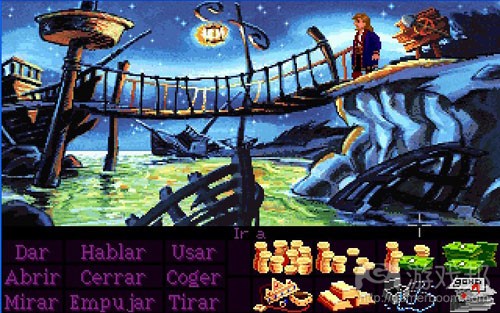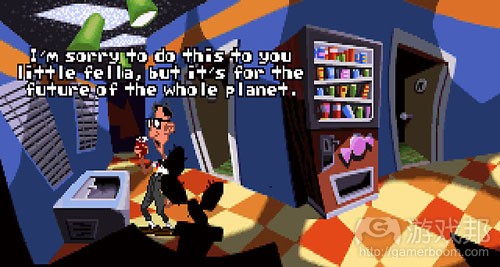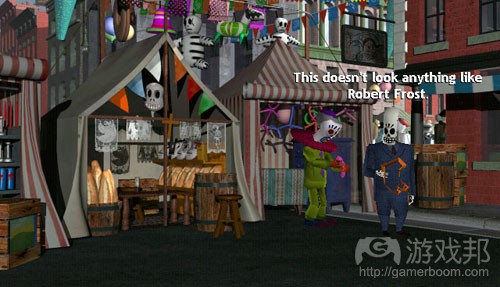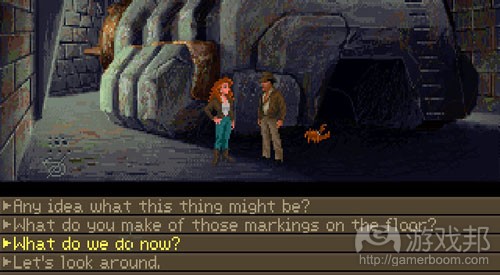LucasArts冒险游戏为何能够成为经典?(1)
作者:Frank Cifaldi
LucasArt今年退出舞台着实是电子游戏行业一大不幸损失,但对我们许多人而言,其意义不仅局限于此。
相较于该公司被取消的项目,传说中被裁员150人,或者像迪士尼这种多样化或国际化的大公司居然如此轻视游戏开发的消息,LucastArt的退场损失更为严重。
对我们来说,LucasArts之死无异于梦想之死。这个梦也许是因怀旧而美丽,但终究还只是个梦罢了。也许在能够于主流游戏开发史中催生出最具创新性工作室的独特环境成形时,这个梦就会卷土重来。
这是一个遥不可及的梦,但只要LucasArt的名字犹存,我们当中的一小部分人就不会放弃这个梦想。
该工作室推出了许多创新,但不可否认的是,该公司的最强大遗产是80至90年代的图像冒险游戏。例如《Grim Fandango》、《猴岛的秘密》、《Zak McKracken》以及《the Alien Mindbenders》等独特、故事性以及通俗易上手的冒险游戏。
如今算起来,距离最后一款出色的LucasArts游戏问世已有15年了,但行业中许多人仍然将这些游戏奉为游戏喜剧写作,以及故事驱动型游戏的标准。
但为什么会这样呢?为什么我们仍然将这些游戏奉为行业的顶点?为什么开发者在讨论自己的游戏故事时还要频频提及《猴岛》?为什么我们仍然在心中将“LucasArts”一词与图像冒险游戏开始前的启动画面联系起来,尽管该公司在过去10年中并未发布一款游戏?
为此,我们通过Facebook和Twitter采访了游戏开发社区的相关成员,提出了以下问题:
让LucasArts经典冒险游戏经久不衰的要素是什么呢?为什么我们今天仍在讨论这些游戏?
我们收到了如下大量回复。
在这些回复中,Lucasfilm Games元老David Fox以内部人的身份发表了独到的见解(见本文第2部分)。
它们经常会打破第四堵墙(游戏邦注:属于戏剧术语,指一面在传统三壁镜框式舞台中虚构的“墙”。它可以让观众看见戏剧中的观众。从另一个层面讲,观众在电影、电视节目中出现,可以被看做是“打破第四面墙”)并让你觉得自己也置身于笑话中。
它令人愉快而鼓舞人心。即使是在今天,我对游戏开发天堂的想象仍然像是起源于自己玩这些游戏时候的体验,以及它们是在世界上最自由和创意的环境中创造出来的暗示。
——Mike Mika(Other Ocean Interactive开发总监)
人们一直在讨论制作喜剧游戏的难度,这也许是真的,但LucasArts却让这个过程看起来很轻松。我每两年都会和妻子一起重温《Day of the Tentacle》,这款游戏确实堪称完美。
我从这款游戏中学到如何成为有趣的人,尽管该游戏要求玩家控制场景的时间,也学到了如果要真正悟出一个笑话你该在何时松手。
——Adam Rippon(Muteki Corporation公司的《Dragon Fantasy》开发者)
它们是将原创主题、有趣的故事与通俗易用的玩法融合在一起的罕见典型。在某些方面,它们实际上难以在许多现代工作室中获得批准,因为创造大预算项目的新IP极具风险。
它们仍然非常重要,因为当今的许多可行创意就是起源于那个黄金时代,前辈们的开拓引导了我们的创新,其怀旧感仍然极具启发意义。
——游戏设计师Tyler Sigman(代表作包括《HOARD》、《Sonic Rivals》)
作为游戏行业人士,我喜欢LucasArts经典冒险游戏的原因在于,游戏行业中的每个人似乎都玩过这些游戏。所以你可以用这些游戏作为大家的讨论话题(例如,“我们需要一个为似Manny的角色”),更重要的是你可以从某人最喜欢的LucasArts冒险游戏中了解对方的喜好和个性。
例如,“你是《猴岛》粉丝?那我懂了。还是关心《Maniac Mansion》中将仓鼠放进微波炉的事情?不错,你喜欢《The Dig》?!好极了,我也是……”
因为人人都玩过这些游戏,它们实际上成了游戏行业人士的性格测试。
——Chris Charla(微软工作室)
对于每位成长为愤世嫉俗的青少年或20岁左右青年的人来说,这些游戏是出自我们同龄人之手的作品。它们对我们过去的生活极富意义,它们是由跟我们走过同一条路的人制作的。
这些游戏经得起时间考验,因为其故事很犀利,并且很尊重观众的智商,极具幽默感,到今天我们仍可见到“Lucasfilm”或“LucasArts”的身影,当我们需要一次伟大的冒险以及同好友分享时,它就会将我们带回孩时的记忆。
——Paul Marzagalli(NAVGTR董事顾问)
《Maniac Mansion》是我第一次玩过的冒险游戏之一,当时我并不是骨灰级玩家……但我还是觉得自己的掌握能力与许多更资深的同龄人一样。
它们是大师级的故事家,其中有许多可爱而令人难忘的角色喷出聪明的对话。在每一次小小的胜利时,我都觉得自己真的成了一名游戏玩家,并且更加清楚地认识到为何如此多精明而有才华人会专注于这项爱好。
——电子游戏PR专员Elizabeth Olson(她在担任《Game Informer》杂志创刊编辑时学到了许多冒险游戏知识)
像Ron Gilbert和Tim Schafer等LucasArts编剧、设计师创造了十分出彩的角色和对话,我认为人们至今仍在讨论这些早期作品的一大原因就是我们仍记得自己最喜爱的游戏场景。
它们还实现了一种不造作的杰出感,不会太把自己当回事。《猴岛2》玩法的结尾是一个奉劝玩家去做除了玩游戏之外的其他任务清单。今天还有谁敢这么做呢?
——游戏作曲人Peter McConnell(曾为LucasArts冒险游戏作曲,其中包括《猴岛2》、《Indiana Jones and the Fate of Atlantis》、《Sam & Max Hit the Road》、《Day of the Tentacle》以及《Grim Fandango》
《猴岛2》对我来说是一个启示!它让我知道自己可以进步!我可能搞砸一切,再次尝试,最终通关!我一直都喜欢这种题材的游戏,但由于难度太大总是无法真正享受其中,最后终于有人说,“嘿,我们只玩有趣的部分怎么样。”我的意思是,游戏中精美的画面、真正有趣的对话,这一切都很棒,但真正令我陷入其中的却是它容易上手的特点。
——Ian Adams(Z2Live工作室游戏设计师)
它们是低压力的机制的胜利组合,并因真正优秀的故事而驱动。
其中许多角色都是有血有肉的形象,他们所处的幻想世界具有大量令人难忘的细节,在许多情况下不时闪现创造者的个性和其他特点。
每款90年代中期的LucasArts冒险游戏本身都是令人回味无穷的,它们一起代表了该工作室辉煌灿烂的黄金时代,其命运与亚特兰蒂斯大陆(游戏邦注:一片传说中有高度文明发展的古老大陆,被称作大西洲)一样突然间在90年代晚期灾难性地陷落在深海之下。
——Craig Adams
《猴岛的诅咒》仍然是我玩过的最有趣的游戏之一。之后是《Loom》这款具有独特用户界面,以非常方式运用音效的游戏。最让我难忘的是《Grim Fandango》这款从旧版SCUMM游戏演变至3D的游戏——它很古怪、好玩、神秘,当然还有独特。
游戏中的技术一直在进步,但游戏设计如果无懈可击,就会久经时间考验。
——游戏设计咨询师和作家Rusel DeMaria
它的游戏世界至今让人觉得具有原创性和新鲜感,其写作也充满智慧和令人难忘,每个角色都是如此特立独行和非凡。
即使是在那个时期,它们也成功地跨越了文化边界。许多跟我同一辈的西班牙人(我的出生地)都还深深记得《猴岛》中人物拿剑决斗赌咒要赢的那些誓言。许多来自欧洲的冒险游戏也将在多方面受到LucastArts游戏的影响,例如直接引用其中的谜题。它们真正令北美地区之外的玩家产生了共鸣。
——研究人员兼学者Chara Fernandez Vara
坦白地说,我都不知道该如何说起,他们有如此多出众的游戏。他们的冒险游戏,例如《Maniac Mansion》、《Day of the Tentacle》、《Escape from Monkey Island》、《Full Throttle》、《Grim Fandango》几乎定义了一个时代。
《Indiana Jones and the Fate of Atlantis》可能是我最喜欢的冒险游戏之一。将 Indiana Jones 与冒险游戏题材结合起来效果真的很棒。对我来说Fate of Atlantis不但是我最喜欢的冒险故事,而且也是史上最佳的 Indiana Jones故事之一。
——Infinity Ward执行制作人Mark Rubin
原文发表于2013年4月5日,所涉事件及数据以当时为准。(本文为游戏邦/gamerboom.com编译,拒绝任何不保留版权的转载,如需转载请联系:游戏邦)
Why are We Still Talking about LucasArts’ Old Adventure Games?
by Frank Cifaldi
This story is being highlighted as one of Gamasutra’s best stories of 2013.
The gutting of LucasArts earlier this week was a tragic loss for the video game industry, but for many of us, it was more than that.
It was more severe of a loss than the cancelled projects, the rumored 150 job losses, or the between-the-lines message that even a company as diverse and global as Disney puts little value in game development.
No, for us, the death of LucasArts was the death of a dream. A dream rose-tinted by nostalgia, perhaps, but a dream nevertheless. A dream that one day, the unique environment that birthed what may have been the most wildly creative studio in mainstream game development history would, somehow, come back.
It was a far-fetched dream, but as long as the name LucasArts continued to exist, a small part of us held onto it.
A lot of innovation came out of the studio, but without a doubt, the strongest legacy it left behind was its series of graphical adventure games from the ’80s and ’90s. Unique, story-driven, easily-accessible adventures with titles like Grim Fandango, The Secret of Monkey Island, and Zak McKracken and the Alien Mindbenders.
By most accounts the last truly great LucasArts (or Lucasfilm Games, if you go back far enough) game was released almost 15 years ago, and yet, many in the industry still hold these titles as the benchmark not only for comedy writing in games, but for narrative-driven games of all kinds.
But why is that? Why is it that we still consider these games among our pinnacle achievements as an industry? Why do developers still namedrop Monkey Island in pitch meetings when discussing their proposed game’s story? Why do we all continue to mentally associate the word “LucasArts” as the splash screen we see before a graphical adventure game, even though the company hadn’t released one in over a decade?
We turned to our game development community to find out. Specifically, we asked via Twitter and Facebook:
What is it about the classic LucasArts adventure games that makes them timeless? Why are we still talking about them today?
We’ve collected a good majority of the answers below. Following these responses, as a special treat, Lucasfilm Games veteran David Fox attempts to answer that question with his own insider perspective.
(Image credits: MobyGames, Lemon64, The Scumm Bar)
Helping Green Tentacle get a recording contract was the least of your worries in Maniac Mansion.
They often broke the fourth wall and made you feel like you were in on the joke. As if the joke was “Can you believe we get to make these things?”
It was exhilarating and inspiring. Even today, my fantasy of what game development nirvana feels like stems from my experience playing those games, and the insinuation that they were created in the most liberating and creative environment on earth.
- Mike Mika, development director at Other Ocean Interactive
People always talk about how hard it is to make a comedy game, and maybe it’s true, but LucasArts made it look easy. I still go back and play Day of the Tentacle every couple years with my wife, and man, that game holds up thanks to its perfect delivery.
From that one game I have learned a lot about how to be funny despite players having control over the timing of a scene, and I learned when you really just have to yank control away from them in order to drive a joke home.
- Dragon Fantasy creator Adam Rippon, of Muteki Corporation
They were that rare combination of original themes and interesting stories mixed with accessible gameplay. In some ways, they are exactly what is hard to greenlight in many modern studios because of the risk of creating new IP on big-budget projects.
They are still relevant because many of today’s working creatives grew up in that golden age, so that trailblazing taught us how to be creative, and the nostalgia continues to inspire.
- Game designer Tyler Sigman (HOARD, Sonic Rivals)
What I love about the classic LucasArts adventures as a game industry person is that it seems like every single person in the game industry has played them. So a) you can use any of the games as shorthand when discussing something (“we need like a Manny character for this”) and more importantly b) you can instantly learn a lot about someone by what LucasArts adventures they like most.
“Ok, you’re a Monkey Island guy? Got it. Still focused on putting the hamster in the microwave in Maniac Mansion? Cool. You like The Dig?! Right on…”
Because everyone has played them, they’re basically a Rorschach test for people in the game industry at this point.
- Chris Charla, Microsoft Studios
Day of the Tentacle’s unique premise saw players finding creative ways to make objects travel through time.
For every adolescent who turned into a snarky teenager or a sardonic twenty-something, here were games made by our peers. They were games that made sense for where we were in life, made by people who walked the same road as we did.
The games endure because the stories are sharp and respect the audience’s intelligence, the humor is inclusive, and because still today when we see “Lucasfilm” or “LucasArts,” it brings us back to those childhood memories when all we wanted was a great adventure and friends to share it with.
- Paul Marzagalli, board of advisors, NAVGTR.
Maniac Mansion was one of the first adventure games I ever played, in the early days of Game Informer. It didn’t seem to matter that I wasn’t an expert gamer… I felt like I got as much out of it as my more veteran peers.
They were expert storytellers, spinning engaging takes with endearing and memorable characters spouting clever dialog. And with each little victory I felt like I was really becoming a gamer and better understanding why so many smart and talented people were dedicated to the hobby.
- Video game PR professional Elizabeth Olson, who cut her teeth on adventure games as the founding editor of Game Informer magazine.
Indiana Jones and the Fate of Atlantis is regarded by fans as a worthy successor to the trilogy of feature films.
LucasArts writers and designers like Ron Gilbert and Tim Schafer brought to the table a wonderful knack for character and dialog, and I think the reason people still talk about those early titles today is that we all have favorite scenes that we still remember.
They also achieved a kind of unstudied greatness that comes from not taking yourself too seriously. Monkey Island II actually ended gameplay with a long list of things you could go out and do other than play video games. Who does that now?
- Game composer Peter McConnell, who contributed music to LucasArts adventures including (but not limited to) Monkey Island II, Indiana Jones and the Fate of Atlantis, Sam & Max Hit the Road, Day of the Tentacle, and Grim Fandango
Monkey Island II was a revelation for me. I could make progress! I could mess up, try again, and eventually get through things! Here was this genre of games that I’d always liked the idea of, but never been able to really enjoy due to difficulty, and someone had finally said, “Hey, how about we ONLY have the fun part.” I mean, the beautiful art, the genuinely funny dialog, all of that was wonderful, but the thing I really fell in love with was being able to actually get through the game.
- Ian Adams, game designer at Seattle’s Z2Live
They were built on a winning combination of low-stress mechanics and propelled by genuinely good writing.
Many of the characters had heart and soul, the imagined worlds they inhabited were crafted with an impressive attention to detail, and in many cases the personalities and some aspect of the of the creators came through.
Each of the mid-’90s LucasArts adventure videogames is memorable on its own, but taken together they represent a studio’s glorious golden age that, in a fate similar to Atlantis (sorry), seemed to suddenly and cataclysmically sink beneath the ocean waves in the late ’90s.
- Craig “Superbrothers” Adams
Full Throttle, probably the only game to ever start you off in a dumpster outside of a biker bar.
The Curse of Monkey Island is still one of the funniest games I’ve ever played. Then there was Loom, a beautiful game with a completely unique user interface that used music in a way never used before or since, as far as I know. Finally on my truly memorable scale is Grim Fandango, a 3D evolution from the older SCUMM games — quirky, funny, mysterious and, once again, unique.
Technology in games is ever improving, but game design, when it’s done impeccably, is timeless.
- Game design consultant and author Rusel DeMaria
Manny Calavera feels a little ripped off in 1998′s Grim Fandango.
The worlds still feel original and fresh, and the writing was witty and memorable, where every character is distinct and remarkable.
Even in their time, they managed to cross cultural boundaries. Many people in my generation in Spain, where I’m from, know by heart most of the insults to win at sword fighting in Monkey Island.
Many adventure games coming from Europe will include nudges to LucasArts games, from direct quotes to similar puzzles (see Ben There, Dan That, or Ceville). They really struck a chord outside of North America.
- Researcher and scholar Clara Fernandez Vara
Honestly, I don’t even know where to begin; they had so many titles that stand out. Their adventures games basically defined an era, with Maniac Mansion, Day of the Tentacle, Escape from Monkey Island, Full Throttle, Grim Fandango.
Indiana Jones and the Fate of Atlantis is probably one of my favorite adventure games of all time. Indiana Jones and the adventure game genre go together… well, like Fedoras and bull whips. And for me Fate of Atlantis delivered not only one my favorite adventure stories but also one of the best Indiana Jones stories ever. Certainly better that the Crystal Skull. Sorry George.
- Infinity Ward executive producer Mark Rubin(source:gamasutra)
下一篇:关于恐怖游戏的玩家心理调查和分析













































 闽公网安备35020302001549号
闽公网安备35020302001549号